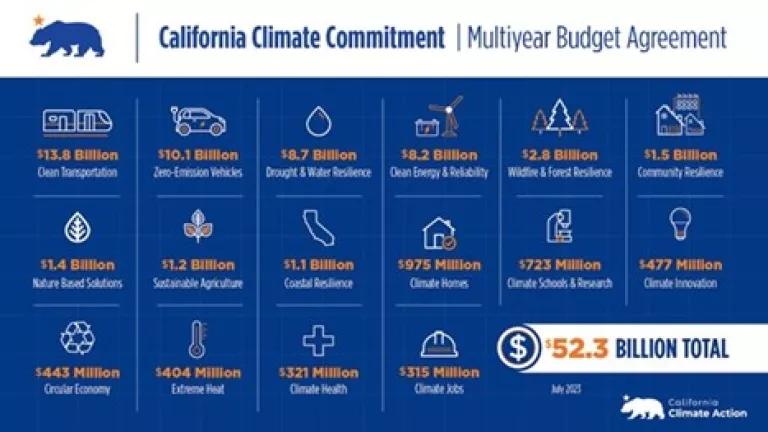Equitable Rate Reform Is Required to Meet Our Climate Goals
California is facing an electric rate crisis. A more progressive rate structure will help fairly pay for system costs while also enabling electrification.

"Wind Power" by CGP Grey is licensed under CC BY 2.0.
This blog is coauthored with Matt Baker, director of the California Public Advocates Office, an independent state organization whose mission is to advocate for the lowest possible utility bills consistent with safety, reliability, and California’s climate goals.
Californians face some of the highest electricity rates in the nation, and the problem is only getting worse. In just the last 3 years, California’s investor-owned utilities’ standard residential rates have increased at an extraordinary pace. For example, residential customer rates are up by 81% for Pacific Gas & Electric and 67% for Southern California Edison. While lower-income residents can access a moderately discounted rate, this has not been enough to blunt the impact of the steep increases we’re facing, especially amid rising temperatures that are intensifying the need for more air conditioning to combat sweltering heat. Currently about 2.4 million customers of California’s three largest investor owned utilities are behind on their electric bills to the tune of $1.8 billion in energy debt.
One major contributor to the utility rates crisis in California is that we fund state priorities in our electricity rates – like billions of dollars for wildfire mitigation each year. This has the impact of increasing the price of clean electricity relative to fossil fuels like gas piped to homes and gasoline for cars and trucks.
This problem is compounded by the inherently regressive nature of power bills, with low-income customers contributing a far greater percentage of their income towards utility bills than high-income customers.
California’s goal to decarbonize the grid by 2045 will require an enormous amount of clean electricity. We need households to replace polluting gasoline and heating fuel with electricity, and to do this we need to ensure that clean electricity is, at the very least, competitive with the price of fossil fuels; and preferably much cheaper.
Without a significant change to the upward trajectory of electricity rates, we will fail to meet our state’s climate goals, fail to address inequalities in our current systems, and fail to decarbonize the grid in the timeframe needed to avoid the worst effects of climate change. It may sound dramatic, but it is a reality that is not hard to imagine if we continue business as usual.
As one of several important actions needed to address this challenge, the California Public Utilities Commission (CPUC) is developing an income-based monthly charge that more equitably shares the costs for electricity infrastructure while also supporting the transition from fossil fuels to clean electricity. The monthly charge would be offset by a decrease in the price of electricity consumed by all Californians served by the investor owned utilities, so that the price of clean electricity better reflects its actual cost to produce and will help provide customers with more economic choices when it comes to switching from fossil fuels to electricity for their cars, water heating, and space heating.
This equitable reform of electricity rates, if well-crafted, will save lower-income earners cash on total bills each month – while lowering the price of electricity for all customers. For example, NRDC’s original joint proposal with The Utility Reform Network (TURN) would decrease total bills for low income households by 15% on average, have negligible impact on bills for moderate income households (1% increase on average), and increase bills for high income households by 16% (note: we only include the top 22% of earners in our "high income" group). And it would reduce the per kilowatt hour rate of electricity by 20-25% to make it more competitive with fossil fuels.
Similar monthly charges have already been implemented in some areas of California. For example, the Sacramento Municipal Utility District (SMUD) has had a monthly charge with a low-income discount for years, and it is a key factor in SMUD’s relatively low electricity prices.
Some have raised concerns that this more equitable rate design will destroy the price signal to conserve energy or will make rooftop solar unattractive. While it’s true that income-based charges will lower the price of electricity – which is vital for affordability – these lower prices will still encourage energy efficiency or rooftop solar because California’s rates will remain extremely high compared to the rest of the country.
No proposals, including the proposal by the state’s major utilities, will alter how much utilities can collect from customers in total. The utilities have put forward a proposal that sets the fixed charge too high, and we would strongly discourage the CPUC from adopting that proposal. However, significant improvement to the current rate structure is necessary and there are other proposals under consideration that reasonably deliver lower electricity prices for all customers and lower total bills for lower income customers.
The path toward electrification is inevitable, but how we get there matters. We must do it equitably. We need rates to encourage households to move toward electrifying appliances and cars, and we need to do it in a way that doesn’t leave people behind.
While an income-based monthly charge paired with lower electricity prices will not solve all the issues driving California’s electricity affordability crisis, it is a significant and much-needed step in the right direction. We’re only at the beginning of a long process to work together to reduce electricity costs in California and move the state toward meeting its climate and clean energy goals, but we are confident that we will get there.




